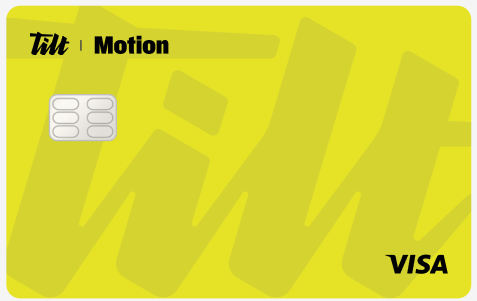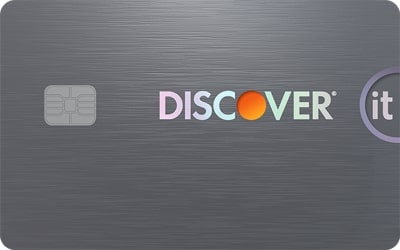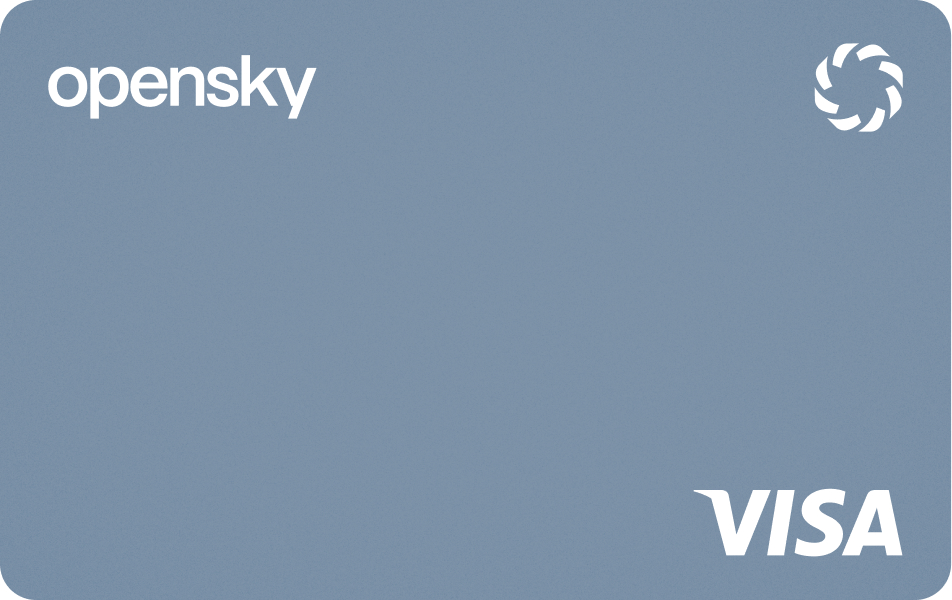Tilt Motion: Build Credit, No Annual Fee or Deposit Required
The Bottom Line
3.5
You’ll avoid many of the fees and pitfalls typically found on other unsecured cards for bad credit. Just be aware that there's an even better card from Tilt, if you can qualify for it.

Rates, fees and offers
Rates, fees and offers
Annual fee
$0
Rewards rate
1%-10%
Bonus offer
None
Intro APR
N/A
Ongoing APR
APR: 28.24%-33.24% Variable APR
Foreign transaction fee
0%
More details from Tilt
More details from Tilt
- No annual fee, and no security deposit required
- 1-10% cash back at select national merchants
- No Credit Score? No problem. Credit history isn't required for approval
- Credit limit increases in as early as 4 months for qualified borrowers
- Build credit alongside hundreds of thousands of Tilt card members
- Tilt reports to all 3 major credit bureaus
- Zero liability fraud coverage
- Card issued by WebBank
Pros and Cons
Pros
No annual fee
Qualify with limited/bad credit
No foreign transaction fees
Reports to the three major credit bureaus
Cons
No bonus offer
No intro APR offer
Detailed Review
The $0-annual-fee Tilt Motion is one of three credit-builder card options offered by financial technology company Tilt and its issuing partner, WebBank.
All three credit cards are unsecured products, meaning they don't require a deposit as collateral. But what helps them stand out from the competition is their unique underwriting process, which can evaluate applicants' creditworthiness without having to rely solely on traditional FICO scores.
The Tilt Motion is the company's midtier card, meant for those with poor to good credit who won't qualify for Tilt's more-rewarding option, the Tilt Essentials card. As with its sibling cards, the Tilt Motion reports to all three major credit bureaus, offers the chance to earn rewards, and features opportunities for credit limit increases. Plus, it's light on the kinds of fees often found on other unsecured cards for bad credit — no sneaky monthly activation or maintenance fees, and no foreign transaction fees, either.
As such, it's a top contender for those with bad or no credit.
For more information on how the Tilt cards compare, see the table below. But here's what to know about the Tilt Motion.
Tilt — under its former company name, Empower — acquired the Petal portfolio of credit cards in 2024. Tilt's three new credit cards have replaced Petal's three cards: the Petal® 1 Rise Visa® Credit Card, the Petal® 1 Visa® Credit Card and the Petal® 2 Visa® Credit Card. Applications for those products are closed, although existing cardholders can still use them.
Tilt Motion: Basics
Card type: Starter; credit builder; bad credit.
Annual fee: $0.
Welcome bonus: None.
Rewards: 1-10% cash back at select merchants.
APR: The ongoing APR is 28.24%-33.24% Variable APR.
Penalty APR: None.
Foreign transaction fee: 0%.
What to know about applying for a Tilt card
Tilt offers three possible credit cards, each targeted at different credit profiles:
The Tilt Engage (for those with poor to good credit who can't qualify for Tilt's other cards).
The Tilt Motion (for those with poor to good credit who can't qualify for Tilt's most rewarding card).
The Tilt Essentials (for those with fair to excellent credit).
You can use Tilt’s pre-qualification tool to see which of Tilt's three cards, if any, is a good fit. (You'll be considered for all three cards and will be offered terms for the one you qualify for.) Pre-qualification doesn’t have any impact on your credit scores. However, if you decide to formally apply, you must submit to a hard credit pull, which can temporarily lower your scores.
How the Tilt cards compare
| Empty Table Header | Tilt Engage | Tilt Motion | Tilt Essentials |
|---|---|---|---|
Annual fee | $59 | $0 | $0 |
Welcome bonus | None | None | None |
Rewards | 1% to 10% cash back at select merchants | 1% to 10% cash back at select merchants | 3% cash back on gas and groceries when you set up autopay; 1% back on other purchases. |
APR | The ongoing APR is 28.24%-33.24% Variable | The ongoing APR is 28.24%-33.24% Variable APR | The ongoing APR is 29.24% Variable APR |
Compare to Other Cards

Benefits and Perks
Accessibility
Thanks to Tilt’s unique underwriting process — the company says it uses “250+ non-traditional signals of financial health” to evaluate creditworthiness — it may be easier to qualify for the Tilt Motion compared with another card from a traditional bank. For example, Tilt says that linking your bank account can increase your approval odds, as it'll show your income and spending habits.
None of the Tilt cards has a security deposit requirement either, and the $0 annual fee on the Tilt Motion makes it easy to keep around long term.
Comprehensive credit reporting
Activity on your Tilt Motion card will be reported to the three major credit bureaus, which compile the information that forms the basis of your credit scores. If you use the card responsibly — keeping credit utilization low and paying balances on time — the credit bureaus will note that information. With a track record of healthy credit habits, your credit scores may eventually increase.
Path to a higher credit limit
Those who are building or rebuilding credit will typically receive smaller credit limits. But Tilt gives its cardholders clear pathways for receiving credit line increases.
First, you’ll receive an automatic increase for linking your bank account with your Tilt card.
Another raise is possible in four months if you demonstrate “positive spending and repayment behavior,” according to a company spokesperson.
And through Tilt’s Leap Program, you can get another limit increase by making six qualifying, consecutive on-time payments. The minimum increase amount is $50.
Note, however, that as of August 2025, Tilt cardholders are only eligible for one credit limit increase through the Leap Program.
Potential for modest rewards
Earning rewards isn't the priority when you’re building or rebuilding credit — but it's a nice bonus if you can get it. The Tilt Motion earns 1-10% cash back at select merchants. Cardholders are automatically enrolled in cash-back offers, no activating or opting in required.
The only redemption option is a statement credit, but there’s no redemption minimum.
Rewards aren’t capped and never expire.
Travel-friendly features
Feel free to pack the Tilt Motion on your international trips. The card doesn’t have foreign transaction fees, and because it’s a Visa, it has broad international acceptance. Rewards may also be earned on qualifying purchases made in a foreign currency.
Tilt offers three kinds of financial products: cash advances, credit cards and a line of credit. Customers are only allowed to have one of those products at a time.
Drawbacks and Considerations
No introductory incentives
Most credit-builder cards don’t come with generous welcome bonuses or promotional APR periods, and that's true of the Tilt Motion, as well. However, there are exceptions to this rule. For instance, if you're willing and able to put down a refundable security deposit, you could consider a product like the $0-annual-fee Discover it® Secured Credit Card. Not only does it earn ongoing rewards, but it also features a unique and potentially lucrative bonus offer, which Discover phrases this way: "INTRO OFFER: Unlimited Cashback Match for all new cardmembers—only from Discover. Discover will automatically match all the cash back you’ve earned at the end of your first year! There’s no minimum spending or maximum rewards."
Limited ongoing rewards
While it's possible to earn rewards with the Tilt Motion card, you'll have to shop with qualifying individual merchants (which may not line up with your spending plans) — and even then, reward rates will vary. The aforementioned Discover it® Secured Credit Card, meanwhile, is less restrictive. It earns 2% cash back at gas stations and restaurants on up to $1,000 in combined purchases each quarter. All other purchases earn 1%. But of course, unlike the Tilt Motion, you'll have to put down at least $200 as a security deposit.
No upgrade path
While the Tilt Motion is a solid option for those with poor credit, there's currently no way to "graduate" to Tilt's best card — the Tilt Essentials — which earns superior ongoing rewards. So once you've used the Tilt Motion to help your credit and are ready to move on to something better, you'll have to open up a new card with a different issuer. Once again, the previously mentioned Discover it® Secured Credit Card could be a better starter option. After you've had the card for seven months, Discover will start automatically reviewing your account each month to see whether you’re ready to move to an unsecured card with the issuer, one that could be even more rewarding. (When you graduate to the new card, your deposit will be returned.)
Alternately, if instead of bad credit you simply have no credit, you might consider a card like the Chase Freedom Rise®. There's no deposit required, you can get it with no credit history, and it earns 1.5% cash back on all qualifying purchases. Plus, Chase will review your account automatically on your card anniversary to see if you qualify to upgrade to the Chase Freedom Unlimited® , which earns richer rewards.
How To Decide If It's Right For You
If your applications for credit have been denied, you probably need a backup plan. The Tilt Motion is a good alternative. Plus, according to Tilt, 50% of people who are approved for a Tilt card were denied elsewhere. Approval odds increase by linking a bank account, so if you already have one, getting the Tilt Motion could be a real possibility.
Upgrade path
This card earns 2% cash back at gas stations and restaurants on up to $1,000 in combined purchases each quarter. All other purchases earn 1%. There's also a welcome bonus. Plus, Discover will automatically review your account each month, starting at the seven-month mark, to see whether you’re ready to move to an unsecured card with better rewards (and get your deposit back).
Looking For Something Else?
Methodology
NerdWallet reviews credit cards with an eye toward both the quantitative and qualitative features of a card. Quantitative features are those that boil down to dollars and cents, such as fees, interest rates, rewards (including earning rates and redemption values) and the cash value of benefits and perks. Qualitative factors are those that affect how easy or difficult it is for a typical cardholder to get good value from the card. They include such things as the ease of application, simplicity of the rewards structure, the likelihood of using certain features, and whether a card is well-suited to everyday use or is best reserved for specific purchases. Our star ratings serve as a general gauge of how each card compares with others in its class, but star ratings are intended to be just one consideration when a consumer is choosing a credit card. Learn how NerdWallet rates credit cards.
About the author

Jae Bratton
Lead Writer & Content Strategist


